A) real GDP is equal to its full-employment level.
B) the conditions of short-run equilibrium are fulfilled.
C) the conditions of long-run equilibrium are fulfilled.
D) all of the above.
E) a and c, but not b.
Correct Answer

verified
Correct Answer
verified
True/False
A decrease in nominal incomes causes a leftward shift in the short-run aggregate supply curve (SRAS).
Correct Answer

verified
Correct Answer
verified
Multiple Choice
Which of the following explains why higher prices in the goods and services market measured by the CPI leads to an upward-sloping aggregate supply curve?
A) The higher prices will temporarily improve profit margins because the cost of wages and salaries are fixed in the short run.
B) The higher prices will reduce the purchasing power of the fixed quantity of money and, thereby, stimulate additional output.
C) The higher prices will expand the economy's resource base and, thereby, stimulate additional output.
D) The higher prices will improve technology and, thereby, stimulate additional output.
Correct Answer

verified
Correct Answer
verified
Multiple Choice
Exhibit 14A-4 Macro AD-AS Model 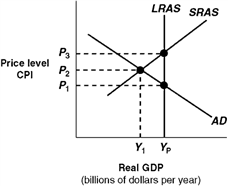 In Exhibit 14A-4, the self-correction argument is that in the long run competition:
In Exhibit 14A-4, the self-correction argument is that in the long run competition:
A) from unemployed workers causes an increase in nominal wages and a leftward shift in SRAS.
B) from unemployed workers causes a rightward shift in SRAS.
C) among firms for workers increases nominal wages and this causes a leftward shift in SRAS.
D) among consumers causes an increase in the CPI and a rightward shift in SRAS.
Correct Answer

verified
Correct Answer
verified
Multiple Choice
The long-run aggregate supply curve is:
A) upward sloping.
B) downward sloping.
C) vertical at full-employment real GDP.
D) horizontal at full-employment real GDP.
Correct Answer

verified
Correct Answer
verified
Multiple Choice
If both the price level and nominal incomes change by the same percentage:
A) real GDP will remain constant.
B) the aggregate supply curve will be upward-sloping.
C) profit margins will change in real terms.
D) the long-run aggregate supply curve will be horizontal.
E) both a and d.
Correct Answer

verified
Correct Answer
verified
Multiple Choice
Beginning from the full-employment level of real GDP, an increase in one of the components of the aggregate demand curve will increase the:
A) average level of prices (CPI) .
B) unemployment rate.
C) natural level of real GDP.
D) level of investment spending.
E) level of government spending.
Correct Answer

verified
Correct Answer
verified
Multiple Choice
One reason for the short-run aggregate supply curve (SRAS) is:
A) a fixed CPI market basket.
B) perfect knowledge of workers.
C) fixed-wage contracts.
D) the upward-sloping production function.
Correct Answer

verified
Correct Answer
verified
Multiple Choice
Exhibit 14A-6 Aggregate demand and supply model 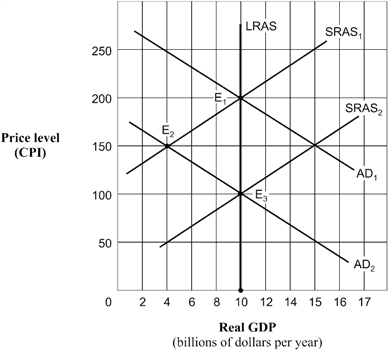 Beginning in Exhibit 14A-6 from long-run equilibrium at point E1, the aggregate demand curve shifts to AD2. The economy's path to a new long-run equilibrium is represented by a movement from:
Beginning in Exhibit 14A-6 from long-run equilibrium at point E1, the aggregate demand curve shifts to AD2. The economy's path to a new long-run equilibrium is represented by a movement from:
A) E3 to E1 to E2.
B) E1 to E3 to E2.
C) E2 to E1 to E2.
D) E1 to E2 to E3.
Correct Answer

verified
Correct Answer
verified
Multiple Choice
Exhibit 14A-3 Macro AD-AS Model 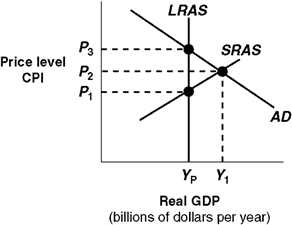 In Exhibit 14A-3, the intersection of AD with SRAS indicates:
In Exhibit 14A-3, the intersection of AD with SRAS indicates:
A) a short-run equilibrium.
B) a long-run equilibrium.
C) that the economy needs policies to reduce unemployment.
D) that the economy is at full employment.
Correct Answer

verified
Correct Answer
verified
Multiple Choice
Suppose that the economy is in a position of short-run equilibrium at a point where real GDP is below the full-employment level. Assuming no further change in aggregate demand and self-correction, the movement to a new long-run equilibrium includes a decrease in which of the following?
A) The unemployment rate.
B) The price level (CPI) .
C) The level of nominal wages and salaries.
D) All of the above.
Correct Answer

verified
Correct Answer
verified
Multiple Choice
Exhibit 14A-6 Aggregate demand and supply model  Based on Exhibit 14A-6, when the aggregate demand curve is in the position AD1, the economy's position of long-run equilibrium corresponds to point:
Based on Exhibit 14A-6, when the aggregate demand curve is in the position AD1, the economy's position of long-run equilibrium corresponds to point:
A) E1.
B) E2.
C) E3.
D) E1 or E2.
Correct Answer

verified
Correct Answer
verified
Multiple Choice
Exhibit 14A-1 Aggregate demand and supply model  Beginning in Exhibit 14A-1 from long-run equilibrium at point E1, the aggregate demand curve shifts to AD2 . The economy's path to a new long-run equilibrium is represented by a movement from:
Beginning in Exhibit 14A-1 from long-run equilibrium at point E1, the aggregate demand curve shifts to AD2 . The economy's path to a new long-run equilibrium is represented by a movement from:
A) E3 to E1 to E2.
B) E1 to E3 to E2.
C) E2 to E1 to E2.
D) E1 to E2 to E3.
Correct Answer

verified
Correct Answer
verified
Multiple Choice
Beginning from a position of long-run equilibrium at the full-employment level of real GDP, the economy's short-run response to a decrease in the aggregate demand curve would be a:
A) movement upward along the short-run aggregate supply curve.
B) movement upward along the long-run aggregate supply curve.
C) downward shift in the short-run aggregate supply curve.
D) movement downward along the short-run aggregate supply curve.
Correct Answer

verified
Correct Answer
verified
Multiple Choice
Exhibit 14A-1 Aggregate demand and supply model 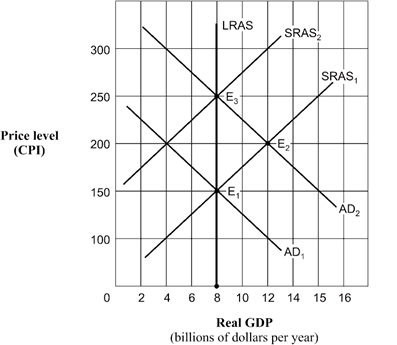 Beginning from short-run equilibrium at point E2 in Exhibit 14A-1, the economy's movement to a new position of long-run equilibrium would best be described as:
Beginning from short-run equilibrium at point E2 in Exhibit 14A-1, the economy's movement to a new position of long-run equilibrium would best be described as:
A) a movement along the AD2 curve with a shift in the SRAS1 curve.
B) a movement along the SRAS2 curve with a shift in the AD2 curve.
C) a shift in the LRAS curve to an intersection at E1.
D) no shift of any kind.
Correct Answer

verified
Correct Answer
verified
Multiple Choice
In an economy where nominal incomes adjust equally to changes in the price level, we would expect the long-run aggregate supply curve to be:
A) vertical.
B) horizontal.
C) unit elastic.
D) negatively sloped.
E) positively sloped.
Correct Answer

verified
Correct Answer
verified
Multiple Choice
Exhibit 14A-6 Aggregate demand and supply model 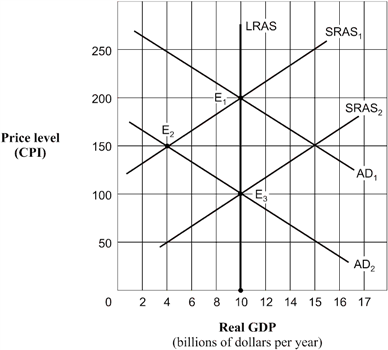 As shown in Exhibit 14A-6, and assuming the aggregate demand curve shifts from AD1 to AD2, the full-employment level of real GDP is:
As shown in Exhibit 14A-6, and assuming the aggregate demand curve shifts from AD1 to AD2, the full-employment level of real GDP is:
A) $10 billion.
B) $4 billion.
C) $100 billion.
D) unable to be determined.
Correct Answer

verified
Correct Answer
verified
True/False
The short-run aggregate supply curve (SRAS) is based on the theory that wages are flexible.
Correct Answer

verified
Correct Answer
verified
Multiple Choice
Which of the following causes a leftward shift in the short-run aggregate supply curve?
A) An increase of goods prices while nominal incomes are unchanged.
B) An increase in nominal incomes.
C) An increase of full-employment real GDP.
D) An increase of personal consumption expenditures while the price level is unchanged.
E) An increase of personal consumption expenditures while full-employment real GDP is unchanged.
Correct Answer

verified
Correct Answer
verified
Multiple Choice
In the short run, an increase in the price level causes which of the following:
A) A rightward shift in the aggregate demand curve.
B) A leftward shift in the short-run aggregate supply curve.
C) A rightward shift in the short-run aggregate supply curve.
D) A movement upward along the short-run aggregate supply curve.
Correct Answer

verified
Correct Answer
verified
Showing 21 - 40 of 83
Related Exams